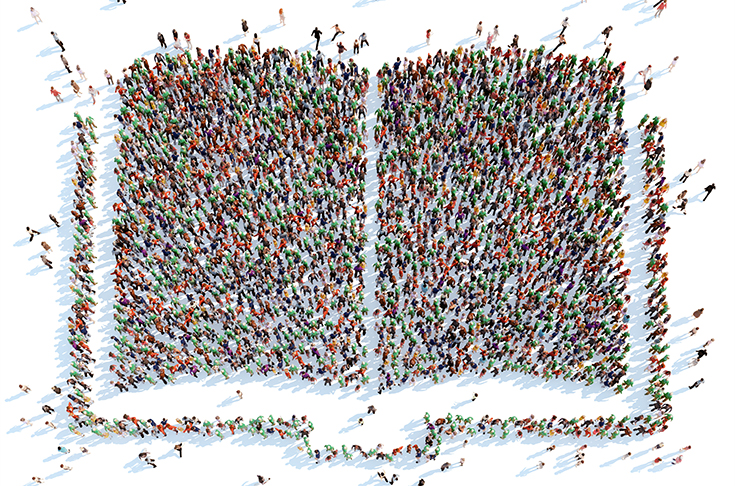In depth: The societal resilience narrative – bringing the chapters together
Laurence Marzell introduces CRJ's new in-depth, longer read blogs, by examining how a more unified and coherent approach to societal resilience might be achieved.

If societal resilience can be described as the narrative, the cumulative effect of the many different and existing activities carried out daily, keeping us safe from harm and promoting our wellbeing, the different activities, domains and stakeholders, can be described as the chapters that lie within it (Roman Fedin/123rf)
Citizens and communities the world over have a commonality that transcends cultural, ethnic or religious boundaries – the shared desire for the safety, security and resilience of the communities in which they live, and the expectation that those in power will protect society from harm and promote its wellbeing.
The popular vernacular used by academics and policymakers alike is societal or community resilience. But is this term understood by the citizen on the street or practitioners on the ground? And, critically, is the role that practitioners play understood in context of the somewhat vague term ‘societal resilience’?
This blog illustrates the components that contribute to societal resilience from a practitioner’s point of view. It also examines how more unified understanding of these structural similarities would support a transformative agenda for societal resilience. This interlinked approach would achieve more meaningful outcomes for citizens by those with the responsibility for their wellbeing.
Cumulative effect
In terms practitioners can understand, the societal resilience narrative can be described as the sum of the parts of many disparate activities and services provided by public, private and voluntary organisations. These are the services that keep communities safe from harm and promote their wellbeing. By no means exhaustive, example activities and domains include: Community policing; serious and organised crime; health and social care; crisis and emergency planning; critical infrastructure protection; public health; education; welfare; fire safety; and local government services.
The challenge between the practical application of these activities and the societal resilience narrative as a single, albeit vague, concept is the lack of understanding of the links between these separate activity domains. This is further compounded by a lack of coherence between policy and practice and, often a fragmented implementation of these services, and therefore the outcomes across the different domains, stakeholders and strategies.
This lack of understanding results in increased risk that dilutes resilience – both its conceptual societal sense as well as in practice on the ground – affecting many areas of daily life for citizens and communities in real terms. So, if societal resilience can be described as the narrative, the many different activities carried out can be described as the chapters that lie within it. But, as a book, the story doesn’t really hang together, because each chapter is seemingly written in isolation, authored by different persons according to their own story and outcome.
This need not be the case. The opportunity to align the narrative of societal resilience with the ‘chapters’ of practical meaning is real and achievable. The different chapters have different perceptions and approaches to risk. The subsequent strategies these engender and the supporting governance, financial and operational delivery regimes are driven by each individual organisation’s view of the world. This is neither right nor wrong, as each has its own specific needs.
Yet those who seek to do us harm, whether through the pervasiveness of serious and organised crime, the scourge of terrorism and radicalisation, or the depravity of child abuse, know no boundaries. Nor do the consequences of natural or human-caused events, such as fire, famine or flood, or the sometimes catastrophic results of inherent human fallibility. Their interconnectivity and the relationships between them are not restricted by the artificial, operational and jurisdictional or geographic boundaries that affect those with the responsibility to keep us safe.
It has been recognised for some time that the threats we face in an interconnected world can only be addressed through more collaborative working between the different stakeholder organisations. Indeed, society couldn’t function day to day without this. However, while effective collaboration is often the norm, at the intersections of these activity domains there are often hidden risks, many of which overlap the operational, jurisdictional and geographic boundaries of governance, information sharing and decision-making. It is here that interdependencies are most exposed to the consequence and cascade effects of risks, threats, vulnerabilities and hazards. It is here where shocks to the system transcend the borders and boundaries between the chapters, undermining both the narrative of societal resilience and its application on the ground.
To ensure the different chapters hang together in a compelling way with a clearly identifiable storyline, the narrative needs editing. A more unified understanding of the disparate activities and their mutual relationships should focus on the interdependencies that exist at the organisational, operational and jurisdictional boundaries; and on the role of these different chapters to the overarching narrative of societal resilience. Within this, we must focus on the shared understanding of risk, the role and relationship of governance and the mutual outcomes sought by the different activities, domains and stakeholders.

Do citizens on the street or practitioners on the ground, really understand the term societal resilience? (Macrovector/123rf)
If the different stakeholders stepped back to first decide their shared and individual risks, then journey forward towards collective outcomes, they would produce a more cohesive and coherent view of the whole. This would empower those with the risk, responsibility, capability and capacity to negotiate together. Likewise, they can then learn together from a more cohesive position to achieve better informed decision-making, bringing societal resilience to life through the Combined Effect, as described by Marzell and Cole, of their collective effort.
For it is here, where similar structural challenges and issues are faced irrespective of domain, that multiple different stakeholders must come together to plan against shared risk and achieve collective outcomes with the most impact. In practitioner’s terms, true societal resilience is the ability for responder organisations and communities to learn and adapt from their own experience collectively; or to learn from the experience of others.
The closer the understanding and collaboration – the storyline throughout all chapters of the book– the more compelling the narrative will be. This fosters shared understanding, in real terms to build and/or affirm resilience across currently separate physical aspects that collectively make up the whole. This ensures we keep getting better at what we do.
Such an approach would not only bring a more dynamic and collaborative understanding of each stakeholder’s role and impact on the whole societal resilience narrative but also encourages increased collaboration with the communities they serve. Together, if individual chapters actually support the storyline, the wherewithal is created for an impact changing and transformative improvement to the actions and outcomes that underpin a more widely understood and achievable definition for societal resilience.
Laurence Marzell, 30/05/2018